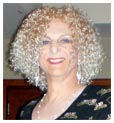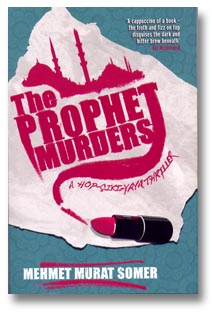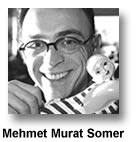BOOK REVIEW — The Prophet Murders — Who’s killing Turkish TVs
 Turkish author Mehmet Murat Somer has a book due for American release in September titled The Prophet Murders, A Hop-Çiki-Yaya Thriller. The most interesting part of this title, for us, is the Hop-Çiki-Yaya* part. (It’s pronounced Hope Cheeky Ya Ya.) Somer uses the term to indicate that his novel is set in the transvestite/gay community of Istanbul. Someone has started murdering transvestites and only the transvestite amateur sleuth who is the hero/heroine of The Prophet Murders has noticed that serial killing is going on, and that all the murdered transvestites’ male names were names of the prophets of Islam. What’s a girl to do? Fix her makeup and get busy finding the killer.
Turkish author Mehmet Murat Somer has a book due for American release in September titled The Prophet Murders, A Hop-Çiki-Yaya Thriller. The most interesting part of this title, for us, is the Hop-Çiki-Yaya* part. (It’s pronounced Hope Cheeky Ya Ya.) Somer uses the term to indicate that his novel is set in the transvestite/gay community of Istanbul. Someone has started murdering transvestites and only the transvestite amateur sleuth who is the hero/heroine of The Prophet Murders has noticed that serial killing is going on, and that all the murdered transvestites’ male names were names of the prophets of Islam. What’s a girl to do? Fix her makeup and get busy finding the killer.
In the first chapter of The Prophet Murders the narrator (who remains unnamed thoughout the book) learns of the  first murder while reading the paper with her morning coffee (in the afternoon). She is a part owner and manager of a transvestite nightclub in Istanbul and she remembers the dead girl as a patron of the club. After her leg waxer, an “older transvestite” named Fatos abla (abla means elder sister) arrives she learns more about the dead girl while having her unwanted leg hair removed. Fatos abla tells her that the dead girl, Ceren, would never have gone to the abandoned building where she was found burned to death. She had an apartment in another part of town and while she was a working girl, as the majority of the Turkish trans community must be in order to make any money, she wouldn’t have gone to the building where she died for a trick.
first murder while reading the paper with her morning coffee (in the afternoon). She is a part owner and manager of a transvestite nightclub in Istanbul and she remembers the dead girl as a patron of the club. After her leg waxer, an “older transvestite” named Fatos abla (abla means elder sister) arrives she learns more about the dead girl while having her unwanted leg hair removed. Fatos abla tells her that the dead girl, Ceren, would never have gone to the abandoned building where she was found burned to death. She had an apartment in another part of town and while she was a working girl, as the majority of the Turkish trans community must be in order to make any money, she wouldn’t have gone to the building where she died for a trick.
Our narrator is not your average Turkish transvestite. As well as being part owner in a successful club, which sounds as if it is delightfully sleazy, she is a computer programming whiz who is as comfortable inside a computer program as she is in a Paris boutique. And, she has friends in high places. (The police chief is a close childhood friend. Wink, wink.)
As more girls from the trans community turn up dead, all murdered in different ways, we learn that they all have male names that echo the names of the Islamic prophets. Ceren’s boy name was Ibrahim which in English becomes Abraham. And the prophet Ibrahim was cast into a furnace by King Nimrod. He, unlike his transvestite namesake, survived when the flames were transformed into birds.
The best thing about this book is the characters. Even in the exotic setting of Istanbul the people we meet—from the leg waxer to the murder victims, and people who assist with the investigation—are all a lot like people we have met in the American TG community. The characters add the life and humor to story. Some of them are going to make you chuckle at least when you recognize them from real life. It almost seems as if the plot is only there to introduce us to the characters, but the story does move along and even though the plot is not too demanding you will find yourself wondering what happens next.
Most TGs reading The Prophet Murders may be disappointed that the narrator only describes a few outfits. If this were TG genre fiction each transvestite’s outfit would have been described in cumbersome detail. I applaud Somer for not overburdening us with wardrobe details but just a couple of sexier outfits would have made it a bit better. She had her legs waxed and then hardly ever wears a skirt!
Which leads to the other thing that will leave you unsatisfied—her tendency to dress as a man for much of the time. When “he” goes to interview a Muslim fanatic computer hacker, whom he considers a prime suspect, he wears his “most masculine” outfit. Not even any eyeliner. Sigh. But I let Somer get away with it since it’s more realistic for the protaganist to do the dirty work in male attire. I know I don’t wear a dress and heels when I slap crooks around. (Just Spandex work out gear.)
The translator, Kenneth Dakan, does a good job converting the original Turkish into English and there are only a few instances when the flow of words seems to be influenced by the cadence and grammar of the original language. Let’s hope that Dakan is the translator for the rest of the Hop-Çiki-Yaya books. There’s the good news. Somer has written six of these so far and is working on more. Since most often novels in a series improve as the writer gets more of them under their belt it’s a good bet that the plots will be better and the characters and settings more fully developed in upcoming stories. The Prophet Murders was published in Turkey in 2003 so Somer has had several years to work on the concept. I’ll be looking forward to the next Hop-Çiki-Yaya book and if the suspicions I harbor are borne out I’ll be reading them all as they become available in the United States.
There are six Hop-Çiki-Yaya books out in Turkey and UK.
The Prophet Murders—A Hop-Çiki-Yaya Thriller
By Mehmet Murat Somer
Translated by Kenneth Dakan
Published by Serpent’s Tail: www.serpentstail.com
ISBN 9781846686337
224 pp, Paperback
US $14.95
Available on Amazon
 *Somer was interviewed in the Guardian and explained what Hop-Çiki-Yaya means: “Hop-Çiki-Yaya was a cheerleading chant from Turkish colleges in the early 1960s, and it came to be used in comedy shows to mean gays. If somebody was queenish, then they’d say ‘Oh, he’s Hop-Ciki-Yaya’. By the ’70s, it wasn’t being used anymore – so I brought it back.”
*Somer was interviewed in the Guardian and explained what Hop-Çiki-Yaya means: “Hop-Çiki-Yaya was a cheerleading chant from Turkish colleges in the early 1960s, and it came to be used in comedy shows to mean gays. If somebody was queenish, then they’d say ‘Oh, he’s Hop-Ciki-Yaya’. By the ’70s, it wasn’t being used anymore – so I brought it back.”
Category: Transgender Fun & Entertainment










